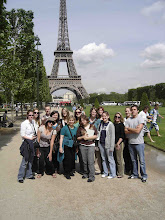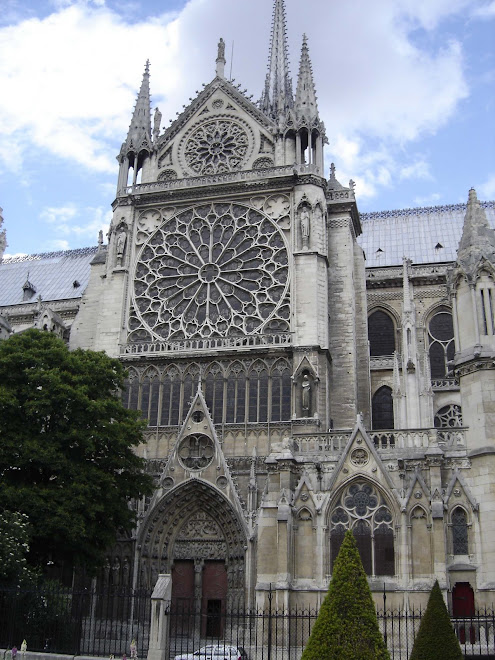

Today was a free day and after sleeping in a while, students with their new found understanding of the Metro system went off to various destinations across the city in small groups. A rail strike outside the metro system prevented some from taking planned day trips to Giverny to Monet's gardens and home, or to Chartres to see the great cathedral. These visits will have to wait until our second free day next week. Places visited included Sacre Coeur, sites at Montmartre, shopping areas, and the catacombs.
As you can see from the pictures above, yesterday the group went to the top of the Eiffel Tower; 1000 feet over Paris they saw the city laid out before them. Visibility was great. This marvel of engineering, designed and built by Gustave Eiffel for the World Exposition of 1889 to demonstrate new bridge building techniques, is made from 7000 tons of iron and was met with disapproval by the artists and writers of the time who thought it ugly and collectively argued for it to be removed. But tastes change and the people grew to admire it as a symbol of Paris's modernity and artistic and scientific leadership in the world of that time. In 1909 when it's 20-year license was up it was nearly torn down; only its importance as a radio telegraphy transmitter saved it. Now it lights up against the Parisian night sky, and "sparkles" on the hour each evening. Students have made the pilgrimage to watch this popular event several times already. We are only a short distance from the Eiffel Tower here in the heart of Paris.
Tomorrow we visit a neighborhood on the right bank (rive droit) referred to as The Marais (the swamp). It once fit this description before the French aristocracy during the time of Henri the IV drained it and built their chateaus in this region that soon became fashionable. We will see Place de Vosges, the oldest square in Paris, and the Hotel de Sully (the word "hotel" is used in this case to mean "home"), an example of one of these aristocratic residences. Then we'll see the Musee de Carnavelet, showing the history of Paris through paintings, models, and transplanted room interiors from various time periods.
Following that we'll move on to the Musee Picasso in the same neighborhood, where students will see a large quantity of Picasso's work that was selected from his own personal collection upon his death in lieu of estate taxes. France and the city of Paris have accumulated a lot of acclaimed art works during the 20th century through this method which is referred to as the "dation." The estates of the artists don't have to pay cash for estate taxes and the government gets great art for the public to enjoy, a win-win situation, at least from the public's point of view.
We're at the halfway point. Time is flying by.
Blogger out!


No comments:
Post a Comment